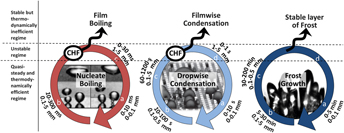Crossref Citations
This article has been cited by the following publications. This list is generated based on data provided by
Crossref.
Boinovich, L. B.
Emelyanenko, A. M.
and
Emelyanenko, K. A.
2015.
Effect of Decanol Vapors on the Delay in Water Droplet Crystallization on Superhydrophobic Substrates.
The Journal of Physical Chemistry C,
Vol. 119,
Issue. 16,
p.
8718.
Birbarah, Patrick
Li, Zhaoer
Pauls, Alexander
and
Miljkovic, Nenad
2015.
A Comprehensive Model of Electric-Field-Enhanced Jumping-Droplet Condensation on Superhydrophobic Surfaces.
Langmuir,
Vol. 31,
Issue. 28,
p.
7885.
Kim, Moon-Kyung
Cha, Hyeongyun
Birbarah, Patrick
Chavan, Shreyas
Zhong, Chen
Xu, Yuehan
and
Miljkovic, Nenad
2015.
Enhanced Jumping-Droplet Departure.
Langmuir,
Vol. 31,
Issue. 49,
p.
13452.
Wang, Tao
Jiang, Yu-Yan
Jiang, Hai-Chang
Guo, Cong
Guo, Chao-Hong
Tang, Da-Wei
and
Rong, Li-Jian
2015.
Surface with recoverable mini structures made of shape-memory alloys for adaptive-control of boiling heat transfer.
Applied Physics Letters,
Vol. 107,
Issue. 2,
Schutzius, Thomas M.
Jung, Stefan
Maitra, Tanmoy
Eberle, Patric
Antonini, Carlo
Stamatopoulos, Christos
and
Poulikakos, Dimos
2015.
Physics of Icing and Rational Design of Surfaces with Extraordinary Icephobicity.
Langmuir,
Vol. 31,
Issue. 17,
p.
4807.
Gouws, G J
and
Shortt, N
2015.
Microstructured silver surfaces produced by freeze casting for enhanced phase change heat transfer.
Journal of Physics: Conference Series,
Vol. 660,
Issue. ,
p.
012045.
Weisensee, Patricia B.
Neelakantan, Nitin K.
Suslick, Kenneth S.
Jacobi, Anthony M.
and
King, William P.
2015.
Impact of air and water vapor environments on the hydrophobicity of surfaces.
Journal of Colloid and Interface Science,
Vol. 453,
Issue. ,
p.
177.
Singha, Sanat K.
Das, Prasanta K.
and
Maiti, Biswajit
2015.
Thermokinetics of heterogeneous droplet nucleation on conically textured substrates.
The Journal of Chemical Physics,
Vol. 143,
Issue. 20,
Kanatani, Kentaro
and
Oron, Alexander
2016.
Nonlinear effect of surface disturbances on mass flux and its modeling in Marangoni dropwise condensation.
International Journal of Heat and Mass Transfer,
Vol. 94,
Issue. ,
p.
419.
Ganne, Agatha
Lebed, Valeria O.
and
Gavrilov, Anton I.
2016.
Combined wet chemical etching and anodic oxidation for obtaining the superhydrophobic meshes with anti-icing performance.
Colloids and Surfaces A: Physicochemical and Engineering Aspects,
Vol. 499,
Issue. ,
p.
150.
Chavan, Shreyas
Cha, Hyeongyun
Orejon, Daniel
Nawaz, Kashif
Singla, Nitish
Yeung, Yip Fun
Park, Deokgeun
Kang, Dong Hoon
Chang, Yujin
Takata, Yasuyuki
and
Miljkovic, Nenad
2016.
Heat Transfer through a Condensate Droplet on Hydrophobic and Nanostructured Superhydrophobic Surfaces.
Langmuir,
Vol. 32,
Issue. 31,
p.
7774.
Mahapatra, Pallab Sinha
Ghosh, Aritra
Ganguly, Ranjan
and
Megaridis, Constantine M.
2016.
Key design and operating parameters for enhancing dropwise condensation through wettability patterning.
International Journal of Heat and Mass Transfer,
Vol. 92,
Issue. ,
p.
877.
Cha, Hyeongyun
Xu, Chenyu
Sotelo, Jesus
Chun, Jae Min
Yokoyama, Yukihiro
Enright, Ryan
and
Miljkovic, Nenad
2016.
Coalescence-induced nanodroplet jumping.
Physical Review Fluids,
Vol. 1,
Issue. 6,
Cha, Hyeongyun
Chun, Jae Min
Sotelo, Jesus
and
Miljkovic, Nenad
2016.
Focal Plane Shift Imaging for the Analysis of Dynamic Wetting Processes.
ACS Nano,
Vol. 10,
Issue. 9,
p.
8223.
Vourdas, N.
Pashos, G.
Kokkoris, G.
Boudouvis, A. G.
and
Stathopoulos, V. N.
2016.
Droplet Mobility Manipulation on Porous Media Using Backpressure.
Langmuir,
Vol. 32,
Issue. 21,
p.
5250.
Saha, Sujoy Kumar
Tiwari, Manvendra
Sundén, Bengt
and
Wu, Zan
2016.
Advances in Heat Transfer Enhancement.
p.
123.
Yamada, Yutaka
Takahashi, Koji
Ikuta, Tatsuya
Nishiyama, Takashi
Takata, Yasuyuki
Ma, Wei
and
Takahara, Atsushi
2016.
Tuning Surface Wettability at the Submicron-Scale: Effect of Focused Ion Beam Irradiation on a Self-Assembled Monolayer.
The Journal of Physical Chemistry C,
Vol. 120,
Issue. 1,
p.
274.
Fukatani, Yuki
Orejon, Daniel
Kita, Yutaku
Takata, Yasuyuki
Kim, Jungho
and
Sefiane, Khellil
2016.
Effect of ambient temperature and relative humidity on interfacial temperature during early stages of drop evaporation.
Physical Review E,
Vol. 93,
Issue. 4,
Wang, Zhangxin
Elimelech, Menachem
and
Lin, Shihong
2016.
Environmental Applications of Interfacial Materials with Special Wettability.
Environmental Science & Technology,
Vol. 50,
Issue. 5,
p.
2132.
Bange, Prathamesh G.
and
Bhardwaj, Rajneesh
2016.
Computational study of bouncing and non-bouncing droplets impacting on superhydrophobic surfaces.
Theoretical and Computational Fluid Dynamics,
Vol. 30,
Issue. 3,
p.
211.
